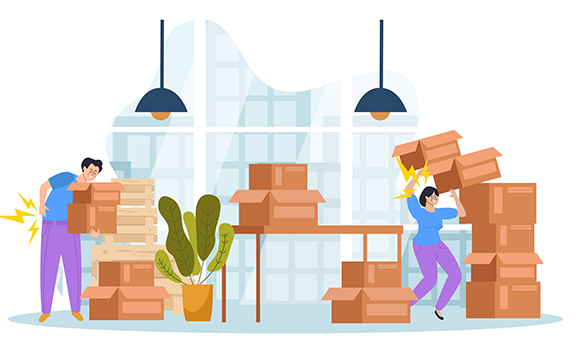Insight Pain Management – Degenerative disc disease is a common cause of back and neck pain that becomes prevalent as people age. It is also prevalent in people with certain occupations and lifestyles that involve repetitive, strenuous movements like heavy lifting. The condition occurs when the intervertebral discs, which act as cushions between the vertebrae and the spine, break down and lose the elasticity that allows them to absorb shock. Over time, this can lead to a range of symptoms, including back or neck pain, stiffness, tingling, and weakness. People with this condition may also lose height, which can contribute to changes in spinal alignment and the development of bone spurs. Although it is not possible to completely prevent degenerative disc disease since factors like genetics and previous injuries contribute to its development, there are likely a few things you are doing that could be contributing to your symptoms. Here are seven bad habits that can make degenerative disc disease worse.
Poor Posture
Your posture could be contributing to degenerative disc disease in several ways. Not only does poor posture increase stress on the spine, it can also lead to misalignment in the spine, muscle imbalance in the back, reduced blood flow to the discs, and impaired ability for shock absorption. There are several simple ways to improve your posture and alleviate your symptoms, including being mindful throughout the day about how you are sitting and standing, using ergonomic furniture that supports proper posture, and taking breaks to stretch and move around.
Sedentary Lifestyle

Maintaining a sedentary lifestyle is another contributing factor to degenerative disc disease. Prolonged inactivity weakens the muscles, reduces flexibility, and leads to obesity, which can worsen spinal problems. To minimize symptoms related to this condition, it is important to incorporate regular physical activity into your daily routine and focus on strengthening the back and core muscles.

Lifting Heavy Objects
Improper or repeated lifting of heavy objects can lead to the development of degenerative disc disease. In addition to putting significant pressure on the spine and intervertebral discs, lifting heavy objects puts excessive strain on the muscles and ligaments and may lead to spinal compression. Awkward movements while lifting can also cause damage. To reduce the risk of developing degenerative disc disease from lifting heavy objects, always bend your knees and hips (not your back), avoid twisting your spine while lifting, and use lifting aids such as dollies or carts.

High-Impact Activities
High-impact activities such as running and jumping lead to a lot of wear and tear on your spine over time. To minimize the risk of developing degenerative disc disease, consider warm-up exercises to prepare your muscles and joints for exercise and cool-down exercises to relax the muscles after strenuous activity. It is also important to learn proper techniques for any high-impact activities you participate in and listen to your body if you are experiencing any pain or discomfort, modifying activities accordingly.
Smoking

Smoking is harmful to our health for many reasons, but you probably have never considered how it is contributing to your degenerative disc disease symptoms? The nicotine and chemicals in tobacco constricts blood vessels and blood flow to the intervertebral discs, depriving them of the ability to repair and regenerate. Smoking is also known to cause inflammation throughout the body, weaken the connective tissues found in the intervertebral discs, and increase the risk of disc herniation.
Excessive Alcohol Consumption
In addition to smoking, excessive alcohol consumption could also exacerbate symptoms related to degenerative disc disease. Chronic alcohol use can lead to nutritional deficiencies essential for maintaining spinal health, dehydration that compromises elasticity of the intervertebral discs, and inflammation throughout the body. Alcohol use also impairs judgment and coordination, which may increase the risk of accidents that can affect spinal health.
Ignoring Pain Signals
When people experience pain, it is common to overlook symptoms believing they are not serious and will go away on their own. However, ignoring or neglecting the early warning signs of degenerative disc disease, such as back pain or stiffness, will likely lead to even worse symptoms as time goes on. If something seems wrong with your body, take initiative as soon as possible by scheduling an appointment with your doctor. Early intervention and open communication will help you avoid complications and ensure you are treating your pain in a healthy and effective manner.

Age, genetics, and trauma or injury all play a role in the development of degenerative disc disease. Although it is not completely avoidable, there are a number of steps you can take to prevent unnecessary wear and tear on your spine. If you are experiencing back and neck pain associated with degenerative disc disease, Insight Pain Management can help you manage your symptoms with a multidisciplinary approach that ensures you are receiving the most effective and personalized treatment plan. Contact us today to schedule an appointment.
FAQ
Q: How is degenerative disc disease diagnosed?
A: Patients experiencing degenerative disc disease often experience back or neck pain. This pain may radiate to the buttocks or legs if nerves are affected. It is also common to experience numbness, tingling, and weakness. To diagnose this condition, physicians will review your symptoms, conduct a physical exam, and order imaging tests to determine the extent of any disc degeneration that has taken place.
Q: Is there a cure for degenerative disc disease?
A: There is currently no cure for degenerative disc disease. However, lifestyle changes and various treatments can help people manage their symptoms and improve quality of life.
Q: Can degenerative disc disease lead to other spine conditions?
A: Yes. When left untreated, degenerative disc disease can lead to other conditions such as herniated discs and spinal stenosis.

